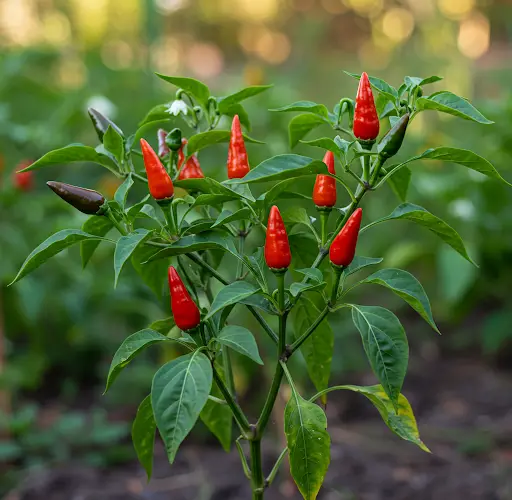Three Key Steps to Growing Healthier, More Productive Pepper and Chili Plants
If you want to grow pepper or chili plants and achieve a large, high-quality harvest, there are three important steps you should follow. These techniques are simple but powerful, and they will significantly improve the strength, structure, and productivity of your plants compared to standard planting methods.
Whether you’re growing bell peppers, hot chilies, or any variety in between, these three methods will give your plants a better start, encourage more fruit-bearing branches, and keep them well-nourished throughout the season.
Step 1: Start with Nutrient-Rich Planting Holes
The first step toward a successful pepper harvest begins with how you plant your seedlings. Instead of simply placing them into the soil, you can give your plants a strong start by preparing a nutrient-rich planting hole.
How to do it:
-
Dig a hole where you plan to plant your seedling. Make sure it is deep and wide enough to hold additional nutrients around the roots.
-
Add compost or worm castings to the hole. Compost improves soil texture, adds organic matter, and helps retain moisture. Worm castings introduce beneficial microbes and enzymes that improve nutrient availability and support strong root development.
-
Sprinkle mustard cake powder into the hole. Mustard cake is a slow-release organic fertilizer that provides important nutrients and also helps repel soil pests. It has natural antifungal properties, protecting the roots from harmful infections.
Mix everything well in the hole to distribute the nutrients evenly. Then, carefully transplant your healthy pepper or chili seedling into the hole. Press the soil gently around the base of the plant to secure it and water thoroughly to help settle the soil. This nutrient-packed foundation gives your plants the boost they need to develop strong roots and vigorous growth from the very beginning.
Step 2: Pinch the Growing Tip to Encourage More Branches
About 15 days after transplanting, when the plant has adjusted to its new environment and has started growing, it’s time for the second step—pinching or cutting the top growing tip.
Why it matters:
This may seem counterintuitive, but removing the top growth of the plant is one of the best ways to encourage it to grow more branches. More branches mean more flowering points, and more flowers lead to more fruits.
How to do it:
-
Identify the topmost growing tip of the plant.
-
Use clean fingers or sterilized scissors to gently remove the tip.
By removing the terminal bud, you signal the plant to redirect its energy into lateral growth, resulting in a bushier plant with more fruit-bearing branches. If you skip this step, your pepper plant may grow tall and spindly, with fewer branches and, ultimately, fewer fruits.
Within a few days of pinching, you’ll notice new shoots forming at the nodes below the pinch point. This simple technique dramatically improves the structure and productivity of your pepper or chili plants.
Step 3: Feed with Nitrogen-Rich Fertilizer at the Right Time
The final key step is feeding your plants with a nitrogen-rich fertilizer that supports leafy growth and healthy branching. Nitrogen is vital for plant development, especially during the vegetative stage. One of the best natural options is yeast liquid fertilizer, which is easy to make at home and contains a good balance of nutrients and growth-promoting compounds.
How to apply:
-
Mix the prepared yeast liquid fertilizer with water according to instructions or a 1:10 ratio (one part yeast fertilizer to ten parts water).
-
Slowly pour the solution around the base of the plant, making sure it reaches the root zone.
This feeding method boosts plant vigor, encourages green leafy growth, and promotes flower development. However, it’s important to apply it in moderation—too much nitrogen can lead to lush foliage but fewer fruits.
Apply this natural fertilizer every two weeks during the growing season. This routine keeps your plants energetic and productive, giving them the nutrients they need to sustain flower and fruit production.
In Summary
By following these three essential steps, you can dramatically improve the health and productivity of your pepper or chili plants:
-
Step 1: Plant in nutrient-rich holes filled with compost, worm castings, and mustard cake powder for a strong root system and healthy start.
-
Step 2: Pinch the top of the plant after 15 days to promote bushier growth and increase the number of fruit-bearing branches.
-
Step 3: Feed with nitrogen-rich yeast liquid fertilizer every two weeks to maintain lush growth and support flowering.
These organic, low-cost practices are simple to implement but make a significant impact on your harvest. With consistent care and attention, your garden will be full of strong, fruitful pepper and chili plants all season long.



